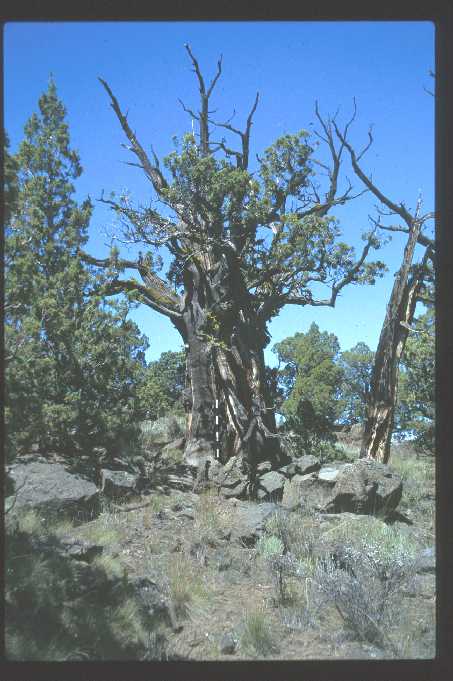 In the Intermountain West, it is estimated that 3 to 5%, or nearly 1.25 million ha, of western juniper woodland is old-growth. Old growth juniper has largely been ignored throughout this region. Attention has primarily focused on the rapidly expanding postsettlement stands of juniper throughout the western United States. Resource inventories, management plans, range improvement practices, research, and wildlife habitat evaluations typically have not differentiated between old-growth juniper and postsettlement woodlands. In addition, work describing old growth stand characteristics has been derived from more mesic heavily forested communities. These stand characteristics may not directly apply to semi-arid woodlands in the Intermountain West. Future work and inventories of old growth woodlands requires criteria for defining old growth across different habitats.
In the Intermountain West, it is estimated that 3 to 5%, or nearly 1.25 million ha, of western juniper woodland is old-growth. Old growth juniper has largely been ignored throughout this region. Attention has primarily focused on the rapidly expanding postsettlement stands of juniper throughout the western United States. Resource inventories, management plans, range improvement practices, research, and wildlife habitat evaluations typically have not differentiated between old-growth juniper and postsettlement woodlands. In addition, work describing old growth stand characteristics has been derived from more mesic heavily forested communities. These stand characteristics may not directly apply to semi-arid woodlands in the Intermountain West. Future work and inventories of old growth woodlands requires criteria for defining old growth across different habitats.
Increasing recognition by land managers and land owners of the existence of these communities has prompted questions about how to recognize old-growth, old growth community structure and composition, ecological importance of old growth, and appropriate management. Our recent efforts have focused on determining the age of old growth woodlands, describing composition and structure, developing criteria for identifying old growth woodlands based on community structure and tree growth form, and measuring abundance and diversity of birds and small mammals in old growth stands.
This study is still ongoing, however, facts of interest are: (1) trees can exceed ages of 1,000 years with the oldest living western juniper aged at 1600 years, (2) trees on arid sites can remain standing dead for hundreds of years, (3) the most extensive stands of old growth typically grow on the wind blown pumice sands of central Oregon, (4) most of these old stands are relatively open, ranging between 10 and 20% tree cover, (5) old woodlands in central Oregon support a relatively high abundance of birds during the breeding season, and (6) these old woodlands provide important avian wintering habitat. We have identified one extensive old growth woodland in the High Desert Ecological Province, which is typically characterized by widely scattered presettlement trees growing on shallow rocky soils. Woodland structure is very different on these igneous soils. Canopy cover ranges from 30% on the south aspect to 50% on the north aspect and few shrubs exist in the understory.
If you are interested in this study, check these recent publications , or contact Rick Miller.
